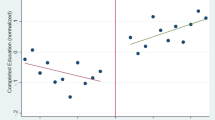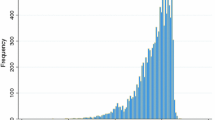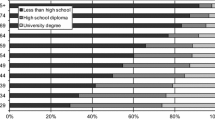Abstract
After declining for many years, there are indications that fertility may be increasing among highly educated women. This paper provides a comprehensive study of recent trends in the fertility of college-graduate women. In contrast to most existing work, we find that college graduate women are indeed opting for families. Data from the Current Population Surveys and Vital Statistics Birth Data both show that fertility increases among college graduate women, especially at older ages since the mid- to late 1990s. There are also increases in fertility among less-educated women, but these are concentrated at younger ages.





Similar content being viewed by others
Notes
Due to data restrictions, we define completed fertility as fertility at ages 40–44. We are aware some women may have children at later ages, but the number is likely to be small.
More loosely related to the current work, Abma and Martinez (2006) study voluntary versus involuntary childlessness, showing a decline in voluntary childlessness between 1995 and 2002. Their results cover all women, not just highly educated women.
A close inspection of Percheski’s results indicates that there is a reduction in childlessness at ages 35 to 39 and an increase in cumulative fertility at ages 38 to 39 starting with her “late baby boom” cohort born between 1956 and 1965. Although she downplays this finding, it suggests an increase in fertility. On the other hand, Percheski finds no reduction in childlessness at ages 30–34, which are the closest her results come to Vere’s estimates of increases in cumulative fertility to 27-year-old women starting with the cohorts born 1966–1967. Thus, their results are in some ways similar and in other ways divergent. These gaps may be due to the differences in the data and measures they use and the Percheski’s focus on professional women.
More distantly related, Bertrand et al. (2010) study MBAs graduates from the University of Chicago’s Booth School of Business, finding that career interruptions from childbirth are responsible for most of the earnings gap among men and women. Using alumnae from Harvard University, Herr and Wolfram (2011) find that the family friendliness of jobs is an important determinant of women’s employment decisions.
The definition of educational attainment in the CPS in and after 1992 is based on the highest degree attained instead of the number of years of school as in earlier surveys. Along with the March CPS and the Vital Statistics data (discussed below), data, the degree-based classification was converted back to one based on years of completed schooling by weighting births by women with a college degree or higher on the new certificates by 1.007599 based on Jaeger (1997).
Before 1985, only 50 % samples are available for some states. Data from these states in these years are weighted to produce nationally representative statistics.
A difference between CPS and Birth Data is that the education data in the Vital Statistics is the education attained at the time of the birth of a child. Education data in the CPS corresponds to the time of interview.
Schooling data is not available for all parts of Arkansas, California, Idaho, New York State, Texas, Washington State, and New Mexico in at least some years. In addition, before 1988, mother education is missing for more than 7 % of the observations in a small number of states that report mother’s schooling. As explained in the Data Appendix, we re-weight our Vital Statistics Birth Data by age and live birth order to account for women without reported schooling. This procedure implicitly assumes that conditional on age and live birth order, non-reporting of schooling does not vary with schooling.
Before 1992, women who have completed exactly 16 years of schooling are coded as “college graduates exactly” and women with at least some of a 17th year of schooling are coded as “graduate educated.”
By contemporaneous classification, we mean that women are classified as college graduates if they have completed at least 16 years of schooling (before 1992) or have a bachelor’s degree or higher degree (in or after 1992).
The Birth Data require us to track cohorts since age 23. Because our data only begin in 1976, we start with the 1954–58 birth cohorts, which allows us to capture the decline in fertility at younger ages, but not the decline at older ages (which is over by the 1954–58 birth cohort).
We define our sample based on education, while Percheski defines hers based on education and occupation. Insofar as women who have more children switch from professional occupations to other occupations, women who are in professional occupations would be expected to experience less (or even no) increase in childbearing even if college graduate women experience increases. We focus on 5-year birth cohorts, while she aggregates to 10-year birth cohorts and her data end before ours.
There are a number of sources of difference between our analysis and Vere’s. We begin tracking women at 23, while he begins tracking women at 22, at which point fertility estimates are quite noisy; his data are based on 38-states without missing data on education, while we correct for missing education data; and his estimates are averages of cumulative fertility of 2-year cohorts up to age 27, whereas our estimates are the averages of 5-year age groups taken at a point in time, which are most comparable to the CPS estimates.
Looking after 1995 among women in their early 40s cumulative fertility among high school dropout women is above 2.5; for high school graduate women, it is around 2; for women with some college, it is close 1.9; for college graduate women, it is around 1.66; and for graduate-educated women it is around 1.5.
Averaging across all years, women with some college have 0.97 children by 25–29; 1.56 children by 30–34; 1.89 by 35–39; and 2.13 by 40–44. By contrast, college graduate plus women have 0.38 children by 25–29; 1.03 by 30–34; 1.52 by 35–39; and 1.74 by 40–44. Thus, the gap closes from 0.59 children at 25–29; to 0.53 at 30–35; to 0.47 at 35–39; and 0.39 at 40–44.
We do not control for marital status because it might be endogenous, but include it below. We do not control for immigration status because the data is not available for earlier years.
California required health insurance plans to cover fertility treatments other than in vitro fertilization in steps in 1989 and 1990; New York took similar steps in 1990, which were expanded in 2002; Texas includes coverage for in vitro fertilization in laws enacted in 1987 and 2003; and Illinois passed laws requiring health plans that provide pregnancy benefits to cover infertility treatments including in vitro fertilization in 1991 and 1996. Among the five largest states, only Florida does not mandate benefits for fertility treatments (see http://www.ncsl.org/default.aspx?tabid=14391).
These estimates are weighted by children, so each child in a set of twins, triplets, etc. is counted separately. Implicitly, higher-order plural births receive more weight.
Plural birth rates initially decline among 40–44 year old women, but reverse dramatically in subsequent years. Race, obesity, and maternal age have all been linked to plural birth rates and changes in the race or age distribution of mothers or in their obesity rates may account for the initial decline.
See footnote 17. It is also noteworthy that the American Society of Reproductive Medicine introduced recommendations in the late 1990s, which were revised in 2004 and 2006, to prevent higher-order multiple gestations.
The multiple birth delivery rate is not reported by education groups.
To obtain the estimate 0.209, we take a weighted average of the plural birth rates for women using ART and non-ART fertility treatments. Schieve et al. (2009) estimate that roughly four-fifths of births using either ART or non-ART treatments are born with non-ART treatments. From their numbers it is possible to estimate a plural birth rate of 18.0 % for women using non-ART fertility treatments. We calculate 0.326 × 20% + 0.180 × 80% = 0.209.
Although there were fluctuations in plural birth rates before 1971, Hoekstra et al. (2008) conclude that changes in the age distribution of women giving birth were a major determinant of these fluctuations.
For instance, D 0 (x i ) = 1, D 1 (x i ) = 1 iff ui > max { − γ 0 x i , − γ 1 x i }; D 0 (x i ) = 0, D 1 (x i ) = 1 iff − γ 0 x i < u i ≤ − γ 1 x i ; D 0 (x i ) = 1, D 1 (x i ) = 0 iff − γ 1 x i < u i ≤ − γ 0 x i ; and D 0 (x i ) = 0, D 1 (x i ) = 0 otherwise.
The increase in fertility conditional on having children in the raw data can be reconciled with the decrease in fertility along the intensive margin implied by the model if the marginal women to have children have somewhat more children than the inframarginal women to have children.
As above, we define changes in cumulative fertility along the intensive margin to be those arising among women who are inframarginal to have children and changes along the extensive margin to be those arising among women who are marginal to have children. The definition here differs from that above because the previous approach explicitly accounts for finite changes between 1995 and 2008 whereas this approach uses a continuous approximation. Formally, in the first approach we define inframarginal women to be those for whom D 0 (x) = 1 and D 1 (x) = 1. In this approach, we define inframarginal women to be those for whom D t (x) = 1 for t = 0 (or t = 1). For differential changes in β and γ the set for which these definitions differ (the set for which \(D_0 (x)\ne D_1 (x))\) is measure zero. The fact that our first approach accounts for finite changes while the other uses a continuous approximation generates some difference in the two sets of estimates.
In a previous version, we show that most of this increase is among women in the 25–29 and 40–44 age groups and that the share of women who have never been married is fairly stable among women in their 30s since the late 1950s cohorts.
When each characteristic is changed separately and the effects are summed, the implied change somewhat exceeds the effect of changing the entire distribution. This difference is due to the covariance in characteristics in the population and to the fact that we generate the marginal effects at the mean of each characteristic.
A previous version of this paper shows that the share of women who have had any children increases among both the never-married and ever-married groups, but the increase among ever-married women dominates the overall increase because the vast majority of college graduate women in their 30s and above have been married.
Goldin (1997) casts doubt on selection as a primary explanation for earlier changes.
Blau and Kahn (2006) find essentially no convergence in the gender pay gap at high quantiles during the 1990s.
References
Abma JC, Martinez GM (2006) Childlessness among older women in the United States: trends and profiles. J Marriage Fam 68(4):1045–1056
Antecol H (2010) The opt-out revolution: a descriptive analysis. IZA Discussion Paper No 5089
Autor D, Dorn D (2011) The growth of low-skill service jobs and the polarization of the US Labor Market. NBER Working Paper No 15150
Bailey MJ (2010) Momma’s got the pill: how Anthony Comstock and Griswold v Connecticut Shaped US Childbearing. Am Econ Rev 100(1):98–129
Belkin L (2003) The opt-out revolution. New York Times Magazine
Bertrand M, Goldin C, Katz LF (2010) Dynamics of the gender gap for young professionals in the financial and corporate sectors. Am Econ J Appl Econ 2(3):228–255
Blau FD, Kahn LM (2006) The US gender pay gap in the 1990s: slowing convergence. Ind Labor Relat Rev 60(1):45–66
Boushey H (2005) Are women opting out? Debunking the Myth. CEPR Briefing Paper
Cohany SR, Sok E (2007) Trends in labor force participation of married mothers of infants. Mon Labor Rev 130(2):9–16
Cortes P, Tessada J (2011) Low-skilled immigration and the labor supply of highly skilled women. Am Econ J Appl Econ 3(3):88–123
Feyrer J, Sacerdote B, Stern AD (2008) Will the stork return to Europe and Japan? Understanding fertility within developed nations. J Econ Perspect 22(3):3–22
Furtado D, Hock H (2010) Low skilled immigration and work–fertility tradeoffs among high skilled US natives. Am Econ Rev: Papers & Proceedings 100(2):224–228
Goldin C (1997) Career and family: college women look to the past. In: Blau FD, Ehrenberg RG (ed) Gender and family issues in the workplace. Russell Sage, New York, pp 20–58
Herr JL, Wolfram C (2011) Work environment and “opt-out” rates at motherhood across high-education career paths. NBER Working Paper No 14717
Hoekstra C, Zhao ZZ, Lambalk CB et al (2008) Dizygotic twinning. Hum Reprod Update 14(1):37–48
Jaeger DA (1997) Reconciling the old and new census bureau education questions: recommendations for researchers. J Bus Econ Stat 15(3):300–309
Martin JA, Hamilton BE, Sutton PD et al (2007) Births: final data for 2005. National Vital Statistics Reports 56(6):24–25
Mazzolari F, Ragusa G (2011) Spillovers from high-skill consumption to low-skill labor markets. Rev Econ Stat 674. doi:10.1162/REST_a_00234
Percheski C (2008) Opting out? Cohort differences in professional women’s employment rates from 1960 to 2005. Am Sociol Rev 73(3):497–517
Rainer H, Selvaretnam G, Ulph D (2011) Assisted Reproductive Technologies (ART) in a model of fertility choice. J Popul Econ 24(3):1101–1132
Reynolds MA, Schieve LA, Martin JA et al (2003) Trends in multiple births conceived using assisted reproductive technology, United States, 1997–2000. Pediatrics 111(5):1159–1166
Schieve LA, Devine O, Boyle CA et al (2009) Estimating the contribution of non-assisted reproductive technology ovulation simulation fertility treatments to US singleton and multiple births. Am J Epidemiol 170(11):1396–1407
Shang Q, Weinberg BA (2009) Opting for families: recent trends in the fertility of highly educated women. NBER Working Paper No 15074
Stone P (2008) Opting out? Why women really quit careers and head home. University of California Press, California
Story L (2005) Many women at elite colleges set career path to motherhood. New York Times
Vere JP (2007) “Having it all” no longer: fertility, female labor supply, and the new life choices of generation X. Demography 44(4):821–828
Wallis C (2004) The case for staying at home. Time Magazine
Author information
Authors and Affiliations
Corresponding author
Additional information
Responsible editor: Junsen Zhang
We are grateful for comments from Martha Bailey, Stephen Cosslett, Jane Leber Herr, Claudia Goldin, Larry Katz, Audrey Light, Trevon Logan, the editor and two anonymous referees, and participants at the University of Michigan, the University of Washington, Seattle, the American Economics Association, and the SOLE/EALE meetings. We naturally take responsibility for all errors.
Electronic Supplementary Material
Below is the link to the electronic supplementary material.
Appendix
Appendix
Figure 6
Cumulative fertility and childlessness for alternative education groupings by age. a. Cumulative Fertility. b. Childlessness. Estimates and associated 95 % confidence intervals for college graduate women from the June CPS using data for 1980–88, 1990, 1992, 1994, 1995, and semiannual data for 1998–2008. Estimates shown for 5-year birth cohorts, with the cohort shown giving the birth year of the youngest members of each cohort
Rights and permissions
About this article
Cite this article
Shang, Q., Weinberg, B.A. Opting for families: recent trends in the fertility of highly educated women. J Popul Econ 26, 5–32 (2013). https://doi.org/10.1007/s00148-012-0411-2
Received:
Accepted:
Published:
Issue Date:
DOI: https://doi.org/10.1007/s00148-012-0411-2





